

Annotated Bibliographies. Summary: This handout provides information about annotated bibliographies in MLA, APA, and CMS.

Contributors:Geoff Stacks, Erin Karper, Dana Bisignani, Allen BrizeeLast Edited: 2013-03-10 11:25:28 Definitions A bibliography is a list of sources (books, journals, Web sites, periodicals, etc.) one has used for researching a topic. Bibliographies are sometimes called "References" or "Works Cited" depending on the style format you are using. An annotation is a summary and/or evaluation. Summarize: Some annotations merely summarize the source.
Common Writing Assignments: Writing an Annotated Bibilography. How to Write an Annotated Bibliography. You have just been given an assignment to write an annotated bibliography.
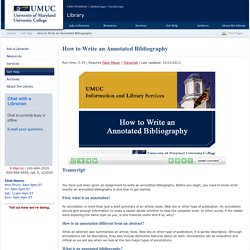
Before you begin, you need to know what exactly an annotated bibliography is and how to get started. First, what is an annotation? An annotation is more than just a brief summary of an article, book, Web site or other type of publication. An annotation should give enough information to make a reader decide whether to read the complete work. In other words, if the reader were exploring the same topic as you, is this material useful and if so, why?
Home - Annotated Bibliographies - Library Guides at University of Washington Libraries. Writing an Annotated Bibliography. Printable PDF Version Fair-Use Policy What is an annotated bibliography?

An annotated bibliography gives an account of the research that has been done on a given topic. Like any bibliography, an annotated bibliography is an alphabetical list of research sources. In addition to bibliographic data, an annotated bibliography provides a concise summary of each source and some assessment of its value or relevance. Depending on your assignment, an annotated bibliography may be one stage in a larger research project, or it may be an independent project standing on its own.
Selecting the sources: The quality and usefulness of your bibliography will depend on your selection of sources. What problem am I investigating? Summarizing the argument of a source: An annotation briefly restates the main argument of a source. Example 1: Only lists contents: McIvor, S. Example 2: Identifies the argument: McIvor, S. The following reading strategies can help you identify the argument of your source:
The Annotated Bibliography - How to Prepare an Annotated Bibliography. An annotated bibliography is a list of citations to books, articles, and documents.
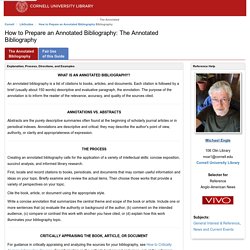
Each citation is followed by a brief (usually about 150 words) descriptive and evaluative paragraph, the annotation. The purpose of the annotation is to inform the reader of the relevance, accuracy, and quality of the sources cited. Abstracts are the purely descriptive summaries often found at the beginning of scholarly journal articles or in periodical indexes. Annotations are descriptive and critical; they may describe the author's point of view, authority, or clarity and appropriateness of expression. Creating an annotated bibliography calls for the application of a variety of intellectual skills: concise exposition, succinct analysis, and informed library research. First, locate and record citations to books, periodicals, and documents that may contain useful information and ideas on your topic. Cite the book, article, or document using the appropriate style.
Annotated Bibliographies - The Writing Center at UNC-Chapel Hill. What this handout is about This handout will explain why annotated bibliographies are useful for researchers, provide an explanation of what constitutes an annotation, describe various types of annotations and styles for writing them, and offer multiple examples of annotated bibliographies in the MLA, APA, and CBE/CSE styles of citation.
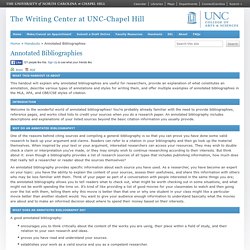
Introduction Welcome to the wonderful world of annotated bibliographies! You’re probably already familiar with the need to provide bibliographies, reference pages, and works cited lists to credit your sources when you do a research paper. An annotated bibliography includes descriptions and explanations of your listed sources beyond the basic citation information you usually provide. Why do an annotated bibliography? One of the reasons behind citing sources and compiling a general bibliography is so that you can prove you have done some valid research to back up your argument and claims.
Critical%20Review%20of%20Scholarly%20Literature. Annotated Bibliography - Organizing Your Social Sciences Research Paper - Research Guides at University of Southern California. I.
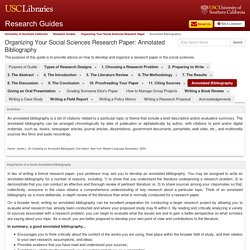
Types Descriptive: This annotation describes the source without summarizing the actual argument, hypothesis, or message in the content. Like an abstract, it describes what the source addresses, what issues are being investigated, and any special features, such as appendices or bibliographies, that are used to supplement the main text. What it does not include is any evaluation or criticism of the content. This type of annotation seeks to answer the question: Does this source cover or address the topic I am researching? NOTE: Strategies about how to critically evaluate a source can be found here.
II. There are two good strategies you should use to begin identifying possible sources for your bibliography--one that looks back into the literature and one that looks forward. The first strategy is to identify several recent scholarly books or journal articles on the topic of your annotated bibliography and review the sources cited by the author(s). III. IV. V. Writing an Annotated Bibliography.pdf. Skip to content. | Skip to navigation Advanced Search… Masterlinks You are here: Home → Dr.
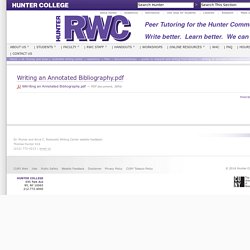
Murray and Anna C.